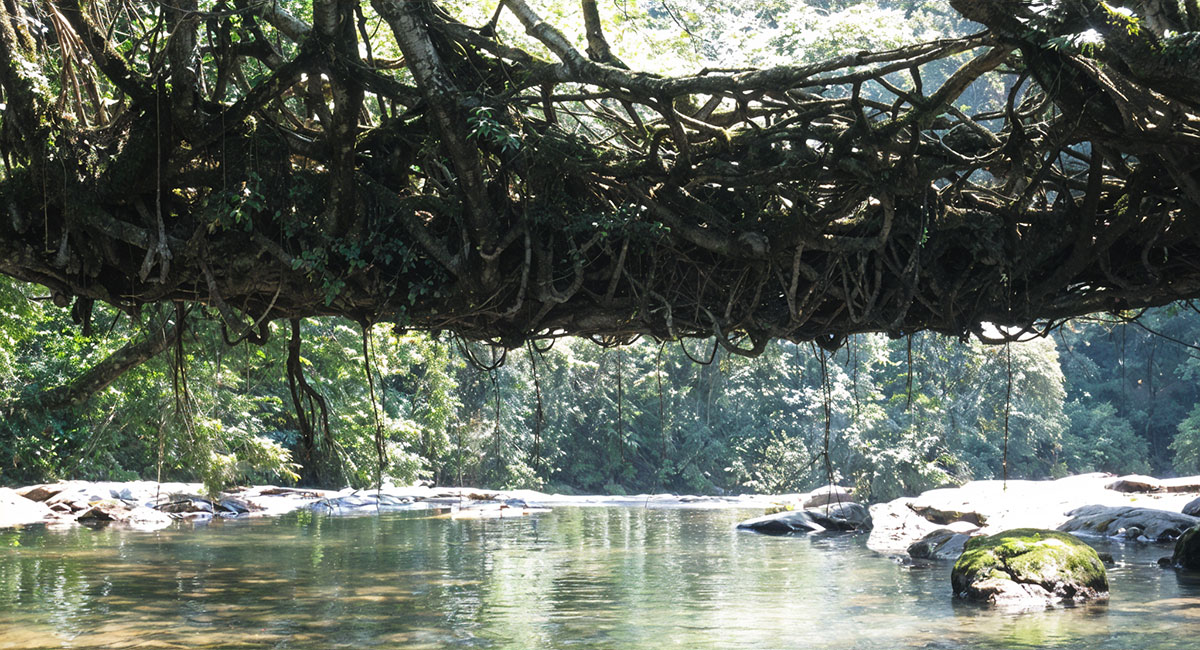The Living Root Bridges of Odisha
Situated deep within the lush green forests of Odisha, far from the bustling cities and popular tourist attractions, lies one of nature’s most astonishing creations: the Living Root Bridges. While most people associate such bridges with Meghalaya, few know Odisha is also home to these remarkable natural structures. These bridges are a noteworthy example of bioengineering and sustainable living, having been constructed by the local populations utilizing the aerial roots of rubber fig trees (Ficus elastica).
Origins and Cultural Significance
Cultivating living root bridges has been passed down for generations among the Indigenous communities of Odisha, particularly the Kandha and Soura peoples. The construction process is an ancient and ingenious technique wherein young, flexible roots of the rubber fig tree are guided across streams, rivers, and ravines using bamboo scaffolding. Over time, the roots grow thicker and intertwine, forming a sturdy, self-sustaining bridge that can last centuries.
For these communities, the bridges are more than just pathways; they are lifelines. They provide essential connectivity in the rugged, forested terrain where conventional bridges made of wood or concrete would be impractical or unsustainable. These living buildings reflect the indigenous wisdom of exploiting natural resources without harming the ecosystem, representing the long-standing harmony between humans and nature.
How Are Living Root Bridges Made?
The process of creating a living root bridge is slow but fascinating. It requires patience, skill, and a profound understanding of plant behavior. The primary steps in their construction include the following:
- Selection of a Suitable Location: The local communities identify where a bridge is necessary, usually over a stream or river.
- Cultivating and Training the Roots: Caretakers carefully guide the rubber fig tree’s young aerial roots using bamboo scaffolding, logs, or hollowed-out betel nut trunks.
- Strengthening the Structure: As the roots grow and extend across the water body, people manually weave and intertwine them with other roots for additional strength.
- Maturation Over Time: The roots become thicker and sturdier over the years. Some bridges take 15-20 years to reach full functionality.
- Continuous Maintenance: Unlike conventional bridges, living root bridges grow stronger over time as people add new roots and reinforce old ones.
Unique Features of Odisha’s Living Root Bridges
Although the living root bridges of Meghalaya are more widely known, Odisha’s bridges have distinct characteristics that make them unique:
- Lesser-Known and Unspoiled: Unlike their counterparts in Meghalaya, Odisha’s root bridges remain largely undiscovered by mainstream tourism, preserving their pristine beauty.
- Varied Ecosystems: Found in the dense forests of southern Odisha, these bridges coexist with rich biodiversity, including rare flora and fauna.
- Different Tribal Techniques: The construction techniques in Odisha slightly differ from those in Meghalaya due to variations in climate, terrain, and traditional knowledge passed down by indigenous groups.
Notable Locations of Living Root Bridges in Odisha
- Malkangiri District: Home to remote tribal settlements where living root bridges help connect villages.
- Koraput Region: Known for its scenic beauty and indigenous heritage, it has deep bridges within its forests.
- Rayagada District: Offers challenging trekking routes that lead to hidden root bridges.
The Ecological and Environmental Benefits
One of the most remarkable aspects of living root bridges is their sustainability. Unlike synthetic bridges, these structures are:
- Eco-Friendly: They are environmentally beneficial because they don’t require steel, concrete, or other non-biodegradable materials.
- Improve Over Time: These bridges strengthen as they age instead of deteriorating.
- Enhance Soil Stability: The dense root systems prevent soil erosion and landslides, particularly in hilly terrain.
- Support Biodiversity: Trees and roots contribute to the local ecosystem by providing habitats for various species of birds, insects, and small mammals.
Trekking and Adventure Opportunities
Visiting Odisha’s living root bridges offers an incredible experience for eco-tourists and adventure enthusiasts. The trekking routes leading to these hidden wonders are scenic, often winding through thick forests, cascading waterfalls, and traditional tribal hamlets. Exploring these bridges provides a look into an age-old way of life that thrives in harmony with nature.
However, these treks can be challenging, requiring stamina, proper gear, and guidance from local communities or indigenous guides. Those who undertake the journey experience breathtaking views and develop an intimate connection with nature that is rare elsewhere.
A Call to Explore and Preserve
The living root bridges of Odisha are not just natural marvels but symbols of resilience, harmony, and sustainability. They serve as a testament to the wisdom of indigenous knowledge and the power of nature-based solutions. As travelers and nature enthusiasts, we must explore such wonders responsibly, ensuring they remain intact for future generations.
Odisha’s hidden living root bridges promise an unforgettable journey into the heart of nature’s ingenuity for those seeking an offbeat, eco-friendly adventure. So, pack your trekking gear, respect the local traditions, and embark on a quest to witness one of India’s best-kept secrets before the world discovers them.


